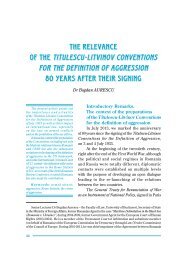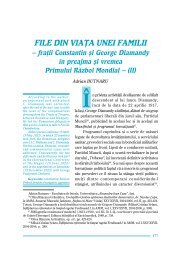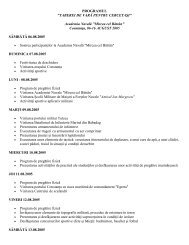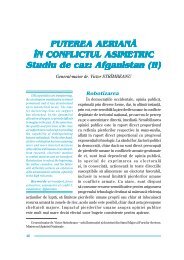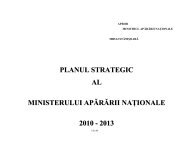You also want an ePaper? Increase the reach of your titles
YUMPU automatically turns print PDFs into web optimized ePapers that Google loves.
developed system, composed from two themes<br />
(Cherson and Lykostomion), and an allied people<br />
(Hungarians), inserted between Bulgaria and the<br />
latent dangerous steppe region. It is very likely<br />
that the last operation in which the fleet of<br />
Lykostomion was involved was the transshipment<br />
of the Hungarians in Bulgaria during the war of<br />
894-896. The failure of the campaign led also to<br />
the end of the ephemeral Danubian theme.<br />
Mesembria was also lost. 39 After the war of 917,<br />
Anchialos entered again under Bulgarian domination,<br />
together with the harbors of Mesembria,<br />
Develtos, Sozopolis and Agathopolis. The Byzantine<br />
domination in the western Pontic space was<br />
seriously damaged. The peace treaty of 927 has<br />
reconfirmed for Bulgaria the possession of<br />
Develtos, Sozopolis, Agathopolis, Anchialos and<br />
Mesembria (it seems that the latter remained free<br />
for the Byzantine navy). 40<br />
In the first half of the 10 th century, the Byzantine<br />
Empire broke the alliance with the Khazars,<br />
no more useful, because their power declined.<br />
When the Pechenegs evolved toward a potential<br />
supremacy in the North-Pontic steppes, it was<br />
necessary to stop this trend by supporting their<br />
rivals, the Rus’. It is true that they were potential<br />
enemies of the Byzantine Empire, but they were<br />
not able to launch offensives toward the Black Sea<br />
if they were hold back by the Pechenegs who<br />
controlled the Dnieper cataracts. By this reason,<br />
it was imperative to keep the hostility between<br />
Russians and Pechenegs.<br />
A persecution of the Christians launched by<br />
the Khazars was the alleged reason for a Byzantine<br />
maneuver, which was intended to oppose two<br />
potential enemies, the Khazars and the Rus’, in<br />
Kerch Strait area. At the request of Romanos I<br />
Lekapenos (920-944), knyaz Oleg started a war<br />
against Tmutorokan, around 940. The city was<br />
captured, but the commander of Kerch, a certain<br />
Pesah, was able to start his own campaign against<br />
Cherson. After the conquest of this city, he<br />
continued the war against the Rus’, defeating them<br />
and requesting them to attack Constantinople. The<br />
invasion took place in June 11 th , 941, under the<br />
common command of Oleg and Igor. A fleet<br />
composed of 1000 small boats sieged the capital<br />
and destroyed the suburbs like in 860, but it was<br />
finally defeated with the intensive use of the<br />
“Greek Fire”. 41 The Byzantine intrigue failed this<br />
time, but the idea of using the Rus’ as an instrument<br />
in the north Pontic policy was resumed after few<br />
years. The Rus’ launched in 943 another attack<br />
against the Khazarian fortresses Sudak and<br />
Tmutorokan. This fact gave to the Russians the<br />
opportunity to settle their control over one side of<br />
the Kerch Strait. Next, the Russians planned a<br />
new inroad in the Byzantine Empire, in alliance<br />
with the Pechenegs, but the invasion did not take<br />
place, because the Byzantines payed knyaz Igor to<br />
stop the war. Igor was thus convinced to close a<br />
treaty with the Byzantine Empire, in 944 or 945.<br />
He obliged himself to defend the isthmus of Crimea<br />
against the “Black Bulgarians” settled north of the<br />
Azov Sea and against the Pechenegs, and to do not<br />
occupy the Dnieper mouth. In the same time, the<br />
treaty allowed to the “Black Bulgarians” to attack<br />
the Khazarian territories in Crimea, because this<br />
matched the Byzantine interests. 42<br />
The Russian attack of 941 made necessary the<br />
improvement of the fighting capability of the navy.<br />
The emperor Romanos I Lekapenos, its former<br />
commander, acted in this direction. 43 It was<br />
supposed that in these circumstances was restored<br />
the port of call from Tomis, recorded in the sources<br />
with the new name Constantia (De Administrando<br />
Imperio, c. 9). The Byzantine ports of calls had in<br />
the same time commercial and military functions. 44<br />
It was already emphasized the increase of the<br />
amount of Byzantine coins at Constanţa in this<br />
period, that could reflect the revival of the port of<br />
call (another one was perhaps at Mangalia). 45<br />
Taking into account the peaceful Bulgarian-<br />
Byzantine relations reestablished after 927, the<br />
settlement of some Byzantine ports of call in<br />
Dobrudja would be not excluded, but we think that<br />
the few archaeological and numismatic remains<br />
can not surely support this hypothesis. From De<br />
Administrando Imperio, c. 9 results that, around<br />
953, Bulgaria mastered Dobrudja up to the Danube’s<br />
mouths, and that Constantia belonged to Bulgaria.<br />
The Russians who navigated along the coast<br />
reached Selinas (the Sulina channel) and from that<br />
point they entered in Bulgaria, a land that included<br />
the next branch of the Danube (Sfântu Gheorghe)<br />
and Constantia.<br />
For the time being, the Rus’ remained an useful<br />
ally for the Byzantines, if they were able to contain<br />
the Pechenegs and to fight against Bulgaria. The<br />
Russian hegemony in Crimea was perceived by<br />
the Byzantine Empire as a way to surround<br />
Bulgaria, which became again an enemy when tzar<br />
26 ����� Review of Military History �����



